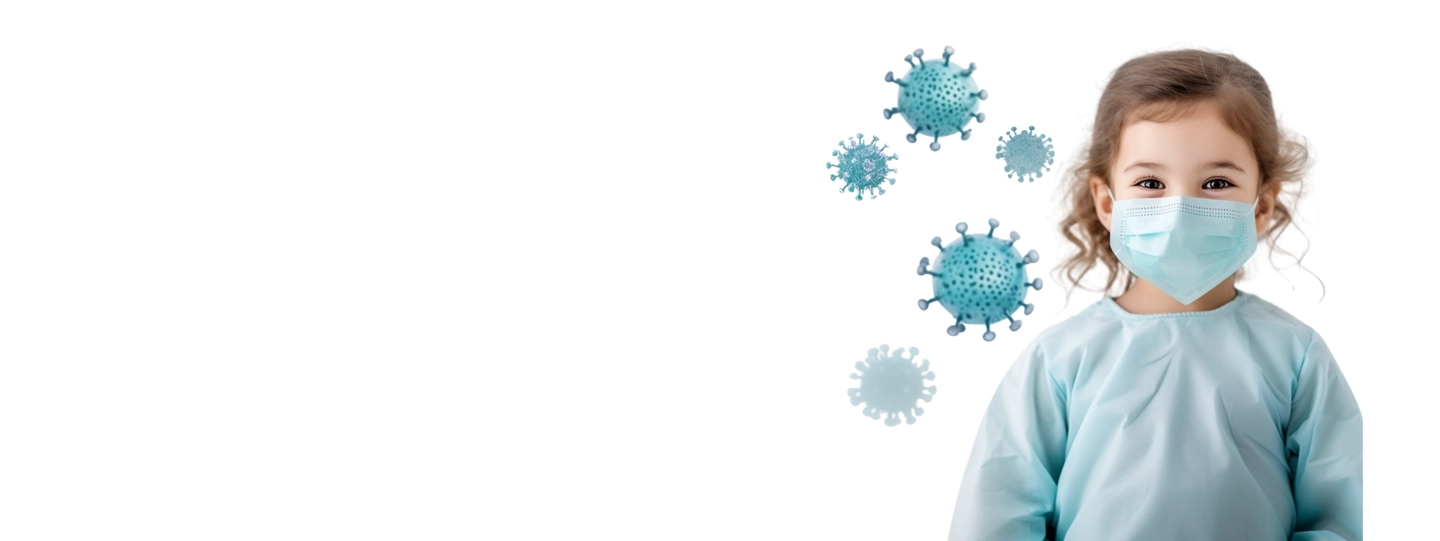

Pediatric infectious diseases are conditions caused by harmful organisms (pathogens) that get into your body from external sources. Infectious diseases are caused by pathogens such as bacteria, fungi, viruses, parasites, and, in rare cases, prions. Infectious diseases can be transmitted by contaminated food, water, or soil, as well as from bug bites and other individuals.
The following are the different types of pediatric infectious diseases:
Bacteria are unicellular organisms (single-celled) with their instructions written on a small piece of DNA. There are bacteria wherever we look, even on our skin and throughout our bodies. While many bacteria are beneficial or even harmless, certain bacteria can cause illness by releasing toxins. Bacteria can survive in almost any type of environment, from extreme heat to intense cold, and some can even live in radioactive waste. There are trillions of strains of bacteria, and few cause diseases in humans. Some of them live inside the human body, such as in the gut or airways, without causing harm. Certain “good” bacteria attack “bad” bacteria and prevent them from causing diseases. However, some bacterial diseases can be fatal. These include:
Apart from the above, other bacterial infections are:
In general, bacterial infections can be treated with antibiotics. However, certain resistant strains survive even after the treatment.
A virus is a bit of information (DNA or RNA) enclosed in a capsid, which serves as protection. Viruses are significantly smaller than human cells and are incapable of self-replication. Once inside your cells, they replicate themselves using the machinery found there. Viruses enter a host and cling to a particular cell. Their genetic material is released as they enter the cell. The virus multiplies as a result of this material forcing the cell to replicate it. New viruses that infect new cells are released by dying cells. Additionally, a virus may specifically target young children or infants.
Viruses may remain dormant for a while before multiplying again. Although the infected individual may seem to be completely cured, a reactivation of the virus could cause them to become sick once more.
Common viral infections include:
Antiviral drugs can assist in reducing some viruses' symptoms while the illness is treated. They have the ability to either stop the virus from spreading or strengthen the host's defenses against the infection's impacts. Antibiotics cannot destroy viruses. The usage of these medications raises the possibility of antibiotic resistance while doing little to stop the virus.
Fungi are diverse organisms, just like bacteria. In your body, they exist. You may become ill if your fungus becomes overgrown or if disease-causing fungi enter your body through your mouth, nose, or any skin cuts.
Common fungal infections include:
Parasites live and reproduce inside the bodies of other organisms. Helminths, or worms, and certain single-celled creatures, or protozoa, are examples of parasites.
Common parasitic infections include:
Anyone can get an infectious disease. If you travel to regions where some highly transmissible diseases are present or if you have a compromised immune system, you may be more vulnerable. An increased chance of contracting an infectious disease is among:
Depending on the sickness type, pediatric infectious disease symptoms vary. Fungal infections typically cause localized symptoms like redness and itching. Bacterial and viral infections can have symptoms in many areas of your body, such as:
There are numerous methods by which infectious diseases can spread, depending on the type of infection. Fortunately, there are easy ways to avoid infection most of the time. Pathogens frequently enter your body through your mouth, nose, and skin cuts. Diseases can spread:
Healthcare professionals diagnose pediatric infectious diseases by conducting lab tests. These include:
The treatment for pediatric infectious disease depends on its type whether it is caused by bacteria, virus, fungi, parasite or others. Pediatric infectious disease treatment includes:
Knowing the wider scope of different types of pediatric infectious diseases is critical to healthcare management. There is an array of bacterial, viral, and fungal, as well as parasitic infections, each requiring a specific strain of prevention and treatment. The key to the control of these diseases is the emphasis on prevention by vaccination and hygiene as well as the avoidance of exposure to disease-causing organisms and the early or prompt diagnosis and treatment of such conditions.
Q1: What are infections and types?
A: Infections happen when microorganisms enter the body and multiply, causing disease and illness. Different kinds of pathogens cause different types of diseases. Mainly they come in four types like bacteria, viruses, fungus, and parasites.
Q2: How are infections transmitted and spread?
A: Many infections can spread in more than one way. Some are transmitted through the air, by contact with an infected person, through blood or body fluids, contaminated food or water, or by insects and animals.
